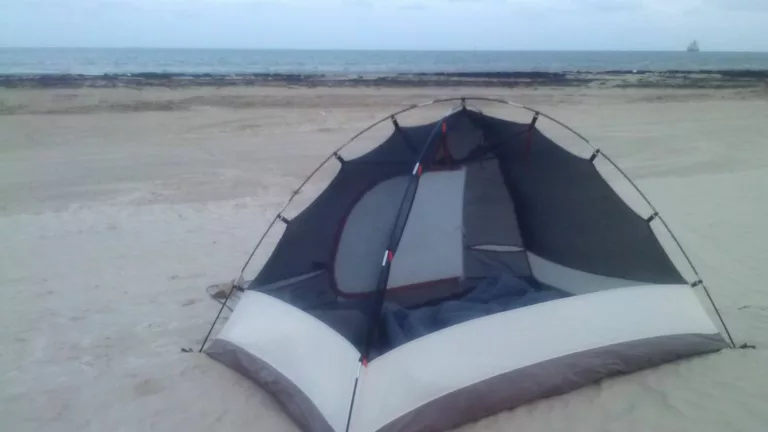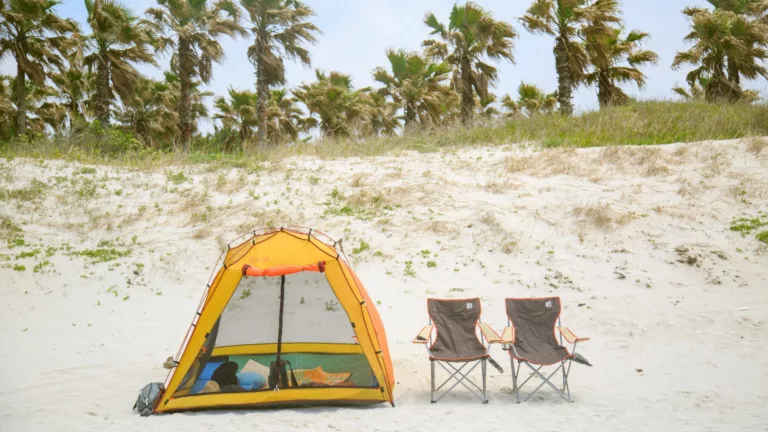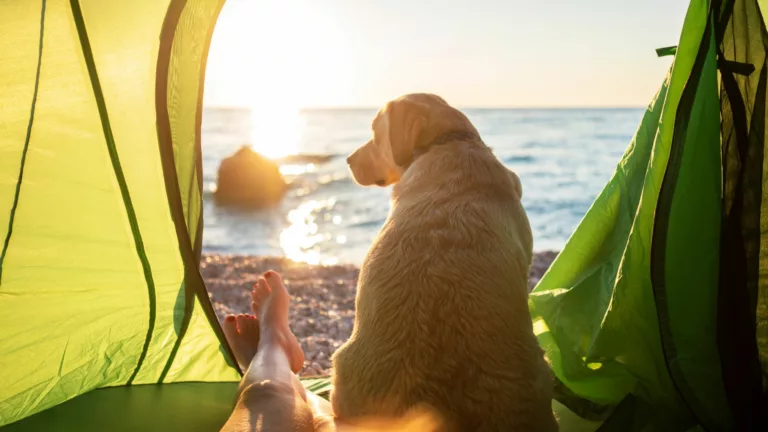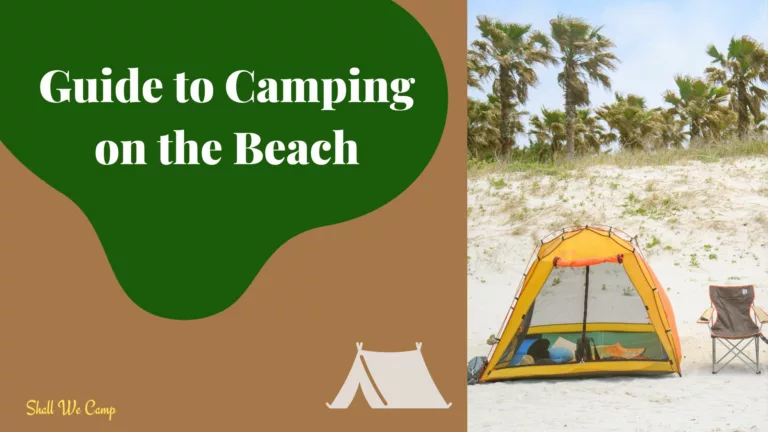Camping on the beach offers a unique blend of adventure, relaxation, and a genuine connection with nature. With careful planning and the right equipment, you can enjoy everything from tranquil nights under a starry sky to lively days by the surf. A well-organized beach camping trip provides a refreshing departure from city life, allowing you to rediscover the simple pleasures of nature.
Take this chance to slow down, reflect on the natural wonders around you, and create stories that will be cherished for years to come.
Taking time to prepare thoroughly, from creating a detailed checklist to arranging your gear optimally, goes a long way in making sure that you overcome common challenges such as shifting sands, tide changes, and strong winds. Some find the idea of camping on the beach a bit daunting and too much work. But I've found that if you use a few tips and tricks to dealing with the sand and weather, you can easily enjoy any beach camping trip.
Affiliate Disclaimer: This site contains affiliate links, which means I may earn a commission on purchases made through these links at no extra cost to you.
Table of Contents
Essential Camping Gear for a Beach Trip
If you want to have a successful beach camping trip, you need to start with the right gear. Camping on the beach comes with its own set of challenges compared to forest or mountain camping, though many basics remain the same. Some items are made specifically for the beach environment, while others from your usual camping kit can still come in handy. Since the beach environment can be unpredictable with wind, sand, and saltwater, having gear that adapts well is extremely useful.
You should consider durable and weather-resistant items:
A waterproof tent or canopy that can withstand sudden gusts is a great idea. Sleeping bags made with breathable fabric can keep you comfortable through cool nights and warm days. And a ground mat or elevated platform can make a big difference on sandy ground.
Don’t forget practical kitchen essentials:
A portable stove, cooking pots, and coolers that can handle the heat.
Consider extra accessories too:
Wind-resistant storage boxes and moisture-proof bags. These additions can help keep your belongings safe even if the weather suddenly shifts.
It may take a bit of extra planning, but the resulting ease and security will go a long way and keep your trip both fun and stress-free.
Getting Started with Beach Camping
Before you head out to the beach for your camping adventure, it’s important to plan carefully. Researching the location is a good starting point. Beaches usually have specific rules and regulations, and some may require permits or be limited to designated camping areas. So be sure to check local guidelines and make sure that you set up your camp in an approved spot and avoid any unnecessary hassle.
Mapping out your gear list ahead of time helps minimize last-minute stress. Consider items you might normally leave behind but that could be very useful on the beach. Sunscreen, bug repellent, and extra tarps can turn what might be a challenging scenario into a comfortable one. Also, be aware of the tide schedule. This will help you avoid setting up camp too close to the water line, preventing unexpected surprises during your stay.
Adding more details to your planning phase can make all the difference. Write down a checklist and schedule a pre-trip visit to the location if possible. This allows you to check the terrain and get a feel for where best to settle. Taking these extra steps not only reduces last-minute rushes but helps seal the plan for a seamless and enjoyable outing.
Quick Tips for a Successful Beach Camping Trip

Once you’ve gathered your gear and done your research, there are several practical steps that can guide you toward a smooth camping trip. While it might feel like there is a lot to remember, breaking everything down into manageable tips makes the process fun and straightforward.
- Plan around the tide schedule: Checking tide times prevents you from choosing a spot that might flood or be too far from the water. It is best to pick a safe, level area that is reliably dry throughout your stay.
- Pick a calm spot: Different beach areas can have varying intensities of wind. Choosing a location near natural windbreaks, such as dunes or rocky outcrops, can protect your camp from strong gusts.
- Prepare for sun and sand: Wear a hat, light clothing, and use sunscreen to protect your skin. Bring extra bags or storage containers to keep sand away from your equipment.
- Set up your campsite wisely: Arrange your tent or shelter so that you maximize space and minimize exposure to direct sunlight. Orient the tent’s opening away from the most common wind direction to maintain comfort throughout the day.
- Double-check local rules: Some regions enforce strict regulations on fires or alcohol consumption, so be sure you are aware of any restrictions where you plan to camp.
Challenges and Considerations for Beach Camping
Like any form of outdoor adventure, beach camping comes with its specific challenges. Understanding potential issues ahead of time can help you prepare a solid plan that minimizes discomfort and setbacks. Issues such as shifting sands and unpredictable weather are important to keep in mind when planning your trip.
Tide Fluctuations
The beach lives by the rhythm of tides. A high tide can unexpectedly bring water closer than you anticipated. This is why it is important to always settle on firm, elevated ground. Keeping a close eye on tide charts and positioning your camp on stable ground rather than on dunes prone to shifting is a key tip for maintaining safety throughout your trip.
Beyond just checking tide schedules, consider marking your camping area on a map and setting reminders for tide changes. This extra planning helps you avoid any last-minute adjustments and keeps your camping zone secure as water levels rise and fall.
Wind and Weather
Wind is one of the major challenges in beach camping. Strong gusts not only disrupt the setup of your tent but also scatter sand in unpredictable patterns. Look for natural windbreaks or use extra weights like heavy rocks or sandbags to secure your tent and sleeping area. Monitoring weather forecasts and adjusting your campsite location accordingly can help you manage these wind conditions more effectively.
In situations where weather shifts unexpectedly, having a backup plan such as an additional canopy or a temporary shelter can be very important. Experiment with different setup configurations during your stay to find what works best against the natural wind flows of the coastline.
Sand Management
Sand can be a bit of a nuisance during a camping trip. It finds ways to infiltrate every piece of gear, from your bags to your clothing and electronic devices. A good tip is to use gear bags that zip up securely and to check them regularly for any sand accumulation. Packing equipment in zip-lock bags makes it easier to brush off the sand once you are back on land.
Many experienced campers recommend having a dedicated sand cleanup kit that includes a small brush and microfiber cloths.
*Pro Tip: We like to use baby powder on our feet and legs before entering the tent. This removes sand like a champ and also leaves us fresh and clean feeling.
Wildlife and Insects
While most beach areas are calm and soothing, you might encounter some wildlife and insects. Bringing insect repellent and sealing food securely is a simple way to avoid unwanted visitors.
In addition, keeping a routine check around the campsite before sleep can further guarantee that no small animals or insects have taken up residence in your gear.
Consider using a pest deterrent like Raid Flying Insect Spray to help cut down on the sand flies and mosquitoes. It works great and has a fresh clean scent.
Advanced Tips for Maximizing Your Beach Camping Experience

After covering the basics, you might be curious about making your trip even more enjoyable and comfortable. Beach camping offers plenty of opportunities to explore creative solutions and small conveniences that give a boost to the overall experience. These advanced tips are designed to help you connect deeper with the beach environment and truly make your stay memorable.
- Optimize your campsite layout: Arrange your tent, cooking area, and seating so you can move fluidly between spaces. By creating distinct zones that function well together, you not only make your campsite look organized but also enjoy a heightened level of comfort and convenience.
- Enjoy outdoor cooking: A portable grill or a small camping stove can go a long way in preparing tasty meals by the shore. Set up your cooking space away from heavy foot traffic and always abide by sand and wind safety measures. Experiment with simple recipes that suit the beach environment for a next-level cool dining experience outdoors.
- Bring light sources: Although the beach is naturally illuminated by moonlight at times, portable, battery-powered lights are extremely handy once darkness falls. Weatherproof and rechargeable lanterns can keep your area brightly lit during nighttime activities.
- Embrace beach activities: Beyond the standard camping routine, consider adding activities such as stargazing, beach volleyball, or a quiet walk along the shoreline. Taking the time to enjoy these moments transforms your camping adventure into a well-rounded experience filled with joy and exploration.
- Practice Leave No Trace: The beauty of the beach should be preserved for everyone. Always collect all trash, dismantle temporary structures correctly, and leave the site exactly as you found it. This environmentally friendly practice protects local habitats and lets future beach campers also enjoy a pristine natural setting.
Planning to cook after sunset? Don’t miss our guide on the best camping lights for night cooking!
The Basics: What to Pack and Prepare

Packing for a beach camping trip requires careful thought about what to bring in order to handle the unique coastal environment. Start by preparing a checklist of essential items. First, focus on protective gear: choose easily washable clothing, sturdy shoes that manage well on sand, and plenty of lightweight layers that adapt from day to night temperature changes. Don’t forget sun protection essentials like hats, sunglasses, and broad-spectrum sunscreen to guard your skin against strong sunlight.
Your camping gear should include a waterproof or at least water-resistant tent, a reliable sleeping bag, and possibly an extra ground cover for insulation against the hot sand. A portable cooking setup is also very important so look for compact stoves and pots that are simple to clean. To complete your kit, pack a first aid kit, a flashlight or lantern, and extra batteries to make sure that you are well prepared for any situation.
- Clothing and Sun Protection: Opt for breathable fabrics and layered clothing so you can adjust easily to the surrounding climate. Sunglasses and hats not only offer protection, but they can also add a stylish touch to your outdoor look.
- Sleeping Arrangements: A quality tent with a waterproof canopy and a snug sleeping bag can significantly affect your comfort. Adding an insulating mat underneath further protects you from the hot sand during cooler nights.
- Cooking and Food Storage: Bring easy-to-cook meals, snacks that do not require refrigeration, and containers designed to keep sand and saltwater out. A portable cooler and sealed food containers will help preserve your food even in the warm beach air.
- Health and Safety Supplies: Always include a well-stocked first aid kit, plenty of water, and effective insect repellent. These supplies play a very important role in ensuring that minor mishaps do not turn into major issues during your trip.
Frequently Asked Questions
Question: Is it safe to camp on the beach?
Answer: Camping on the beach can be a safe and enjoyable experience if you take the proper precautions. Checking tide schedules, securing your tent well, and following local guidelines are all important steps to maintain safety during your stay.
Question: What kind of tent is best for beach camping?
Answer: A waterproof or water-resistant tent that can withstand wind and sand is ideal. Certain tents are specifically designed for beach environments and offer extra stability when set up properly.
Question: How should I manage sand and salt with my gear?
Answer: It helps to choose gear that can be easily cleaned and stored securely in sealed bags. Consider items that are less sensitive to salt damage and make sure to rinse them thoroughly after your trip when possible.
Question: What activities can I enjoy while camping on the beach?
Answer: Beach camping opens the door to various activities such as stargazing, leisurely beach walks, water sports, and sometimes even small permitted fires. Engaging in these activities lets you truly enjoy the natural beauty of the beach and create lasting memories.






